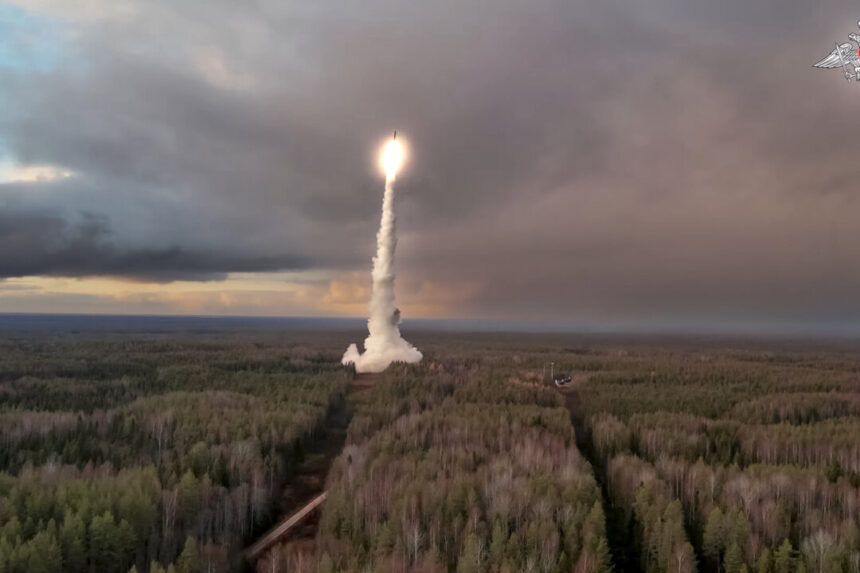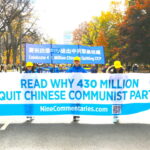A former CIA officer warns that Putin is not just bluffing when he practices for the end of the world, citing Russia’s reconsideration of its nuclear doctrine and recent missile tests. The ambiguity in Russia’s stance on nuclear weapons raises questions about the West’s assessment of risk and the significance of nuclear doctrine. Putin’s warnings about Ukraine’s use of longer-range weapons and potential changes to Russia’s nuclear doctrine suggest a shift in posture. However, experts suggest that Russia’s use of nuclear weapons would only occur in desperate scenarios. Overall, there is concern about the growing nuclear tensions and the need to carefully navigate the situation to avoid catastrophic consequences.

Peace activists wearing masks of Russian President Vladimir Putin (L) and U.S. President Joe Biden pose with mock nuclear missiles in front of the U.S. embassy in Berlin, Germany, on Jan. 29, 2021. John Macdougall/AFP/Getty Images
The START treaty also limits the number of warheads that can be deployed in intercontinental ballistic missiles (ICBMs).
No ‘First Strike’ Capability
Podvig noted that the Soviets, or Russians, never had the ability to launch a “first strike.”
“The Soviet Union never had the capability to destroy more than about half of the U.S.’s ICBMs,” he explained.
“The Americans actually had this capability of a first strike, in the sense that they would have an advantage after an attack—meaning they could kill with their remaining force, 50 million people, and the Soviet Union would be able to kill 30 million.”
He mentioned that the Russians officially declared a “no first strike” policy in 1982, something that the United States and NATO have not expressly stated.
However, the concept of mutually assured destruction has prevented either side from testing the other’s resolve.
“The name of the game” is to send signals to keep the other side cautious, and both sides understand the importance of “escalation control,” according to Podvig.
He added that the United States is cautious about becoming too involved in Ukraine out of fear that situations might spiral out of control.
There is a risk that “Russia will respond in some way, and then the West will respond in some other way,” Podvig stated.
“You get into this escalation, and nobody has confidence that this escalation can be controlled … This is a kind of a cycle that goes all the way up and ends up with the kind of full-scale nuclear exchange.”
Russians ‘Send a Message’
Ripley emphasized that it’s about sending a message.
“When the Russians talk about what’s in their secret document, it means they want to send a message. This isn’t WikiLeaks. This is the Russian government talking about their own secret document, and they’re doing that for a reason, a deliberate reason to send a message: ‘We have this stuff, [so] think carefully about what you do,’ and they’ve used it several times in the past,” Ripley explained.
As part of the Oct. 29 drills, the Russian Defense Ministry announced that the Novomoskovsk and Knyaz Oleg nuclear submarines conducted test-firings of ICBMs from the Barents Sea and the Sea of Okhotsk, while nuclear-capable Tu-95 strategic bombers performed practice launches of long-range cruise missiles.

Peace activists wearing masks of Russian President Vladimir Putin (L) and U.S. President Joe Biden pose with mock nuclear missiles in front of the U.S. embassy in Berlin, Germany, on Jan. 29, 2021. John Macdougall/AFP/Getty Images
The military also test-fired a Yars ICBM from the Plesetsk launch pad at the Kura testing range on the Kamchatka Peninsula.
Faddis highlighted the destructive power of these weapons.
“A single one of the warheads carried by the Yars missile impacting anywhere in the DC area would effectively destroy the entire metropolitan area. Those people not killed outright by the blast would find themselves living in a nightmare,” he stated in his Substack article.
The Oct. 29 test followed a joint nuclear exercise earlier this year that Russia conducted with their ally Belarus, which has hosted some of Moscow’s tactical nuclear weapons.
Before the collapse of the Soviet Union, nuclear weapons from the communist state were stationed in several Soviet republics, including Belarus, Kazakhstan, and Ukraine.
Ukraine Lost Nuclear Arsenal
The newly independent state of Ukraine was ironically pressured by the United States to relinquish its nuclear weapons in 1994.
While it may seem like a mistake in hindsight, Podvig explained that it simply “wasn’t an option” for Ukraine to retain them at that time.
He mentioned that Russia inherited the Soviet Union’s right to possess nuclear weapons, and the West was keen on avoiding more countries with nuclear weapons, especially new and potentially unstable nations.
“There was quite a bit of pressure on Ukraine to become a non-nuclear weapons state, which meant sending all the weapons to Russia,” Podvig elaborated.
“The United States pressured Ukraine significantly on that. They presented a choice: ‘You either remain in good standing with the United States and with the international community in general and become a member of the Non-Proliferation Treaty, or you keep those weapons, and you are on your own—you won’t have any help or investment or anything.’”
Associated Press and Reuters contributed to this report.
Please rewrite this sentence.
Source link





